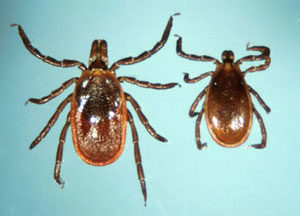
Everyone has that one creeper that makes their skin crawl. For some it’s spiders, for others it’s snakes, mice, rats, or centipedes. But two insects in particular will make the average Minnesota want a thorough check to make sure they’re nowhere to be found:
The first one is head lice (you can itch your head now), and the second? Ticks.
You would be hard pressed to find anyone who has spent time in a Minnesota field or wooded area that doesn’t have at least one wood tick story. I myself have a personal record of finding fifteen of those bad boys on me once after mowing the lawn. Needless to say I didn’t sleep very well that night.
And, sorry to tell you, this year is looking to be a banner year for ticks in general.
The mild winter we experienced didn’t kill as many ticks off as normal, and allowed for a surge in the mouse population. One of the main food sources for ticks is mice, so their population and the number of ticks we encounter go hand in hand. This is also cause for concern as mice are common carriers of Lyme disease, and are the main reason that ticks become infected with it. According to this article from NPR, mice are responsible for infecting up to 95% of the ticks that feed on them.

The main transmitter of Lyme Disease in Minnesota is the Black Legged tick, more commonly known as the Deer Tick (photo at right).
There is some disagreement on how long it takes for a wood tick to transmit Lyme disease to a host: One article from lymedisease.org has the official time at 24 hours for Lyme disease to be transmitted, but there have been research studies that show Lyme disease can be transmitted in as little as six.
People are most at risk for Lyme disease from around mid-May to mid-July, when ticks are in their nymph stage and are feeding; the risk ramps up in spring but then drops as things begin to cool down around September and October.
The Minnesota DNR page has a list of some things you can do though to try and lessen the chance of a bite from a tick:
- Walk in the middle of a trail to avoid picking up a tick from grass and brush
- Wear light colored clothing so that ticks are more noticeable
- Tuck pants into socks and wear a long sleeved shirt tucked in
- Use a repellent that contains DEET or permethrin (and if you would rather go all-natural, here is a recipe I found)
- After being outdoors in an area ticks can be found do a tick check. Get out of your clothes, shower, and dry off with a towel
Now if you end up finding a tick that has attached itself to you, someone you know, or a pet, don’t panic. Do the following:
- Use tweezers to grab the tick close to its mouth, avoid grabbing the body
- Gently and SLOWLY pull the tick straight outward
- Wash the bite area with an antiseptic
- Keep an eye out for any early signs of Lyme disease that include fatigue, a red ring around the bite area, and flu-like symptoms
Have a great summer, go on as many adventures as you can, and make sure to enjoy Minnesota’s natural forests and fields.
Just make sure to check for ticks when you’re done.
















